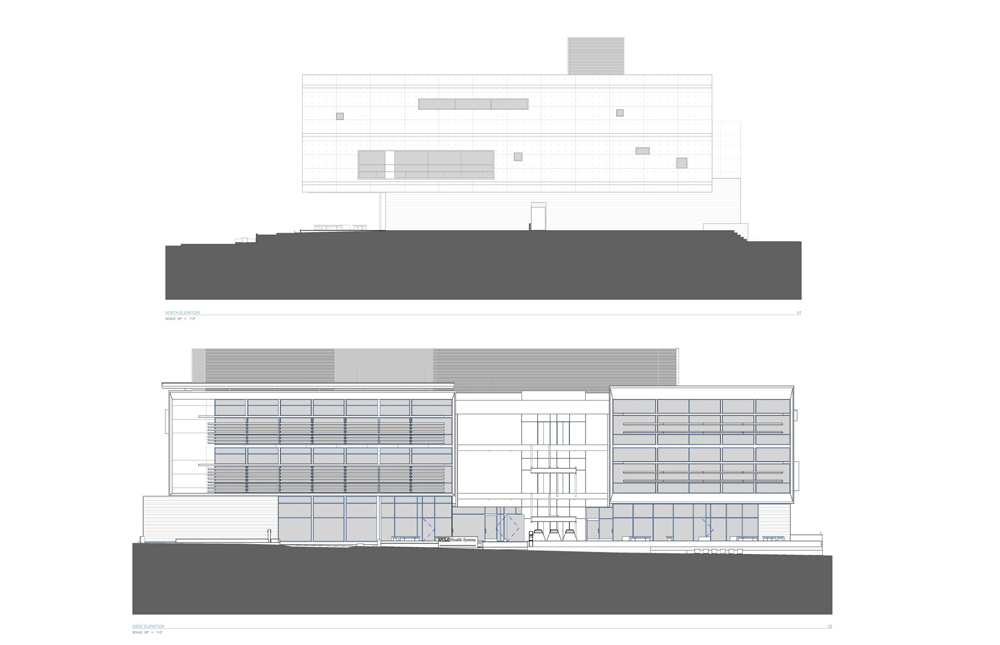
















Michael W. Folonis Architects (MWFA) designed an inspiring healthcare center with a focus on patient experience and sustainability. The award-winning building—slated for LEED Gold certification—is an elegant balance of aesthetics, efficiency, and sensitivity. The massing of the building consists of two great rectangular volumes in a combination of boardformed and cast-in-place concrete, fronted with glass, louvers, and light shelves. The two distinct volumes are joined by a glass box creating a grand atrium bathed in natural light. The imperatives of transparency and function, and the aesthetic of early California Modernism, are all richly evident in the passive solar design, the building skin’s glass and concrete, the interior’s exposed steel, and sweeping sight lines both inside out and outside in. The presentation is bold, yet there is seasoned, mature balance here: A serious tone, equal to the mission of a leading-edge healthcare center, is given a solid form with physical lightness. The building deploys its aesthetics, materials, and features to meet the comprehensive needs of patients and families, doctors, nurses, staff, and students. The design also communicates in part to visitors by suggesting a guiding beacon, transparent and open during the day, and glowing with warm light at night. The form is set back 45 feet from the street to allow for visitor-friendly landscape. The atrium, behind a point-fixed facade glazing system and beneath a fritted glass roof, is a great open room thus bathed with diffused light. The great room contains a bent-beam cantilevered staircase, glass-enclosed elevators, and two sky-bridges leading people efficiently between the north and south volumes. Ample expanses of bamboo on floors, walls, stairs, and ceilings add elegance and a feeling of warmth. Live bamboo thrives in a cor-ten steel interior planter alongside a waiting bench. The north volume, with oncology areas fortified in steel and concrete, provides security, privacy and sensitivity for patients, doctors, and nurses. There are private patient entrances, exterior louvers to further enhance privacy while diffusing solar radiation, and preparation and recovery rooms featuring natural light. An outdoor waiting area provides a serene option for visitors. The linear accelerator rooms comprise one million pounds of concrete imbedded with three layers of lead. Despite the imposing equipment and three-foot-thick walls, the rooms are humanized with the continued use of bamboo flooring and walls. The south volume contains an expansive, well-appointed waiting area that is open to the atrium as well as to an outdoor patio. The outdoor landscaped waiting area features L-shaped wood-topped concrete benches for added privacy. The space is protected from direct sunlight and excessive solar heat gain by shade created by a 25-foot cantilever over the patio. Throughout the south volume, sidelights, clerestory windows, and fixed louvers admit and manage natural light with efficiency and sensitivity. Second-floor surgery center features eight identical surgical rooms along the south side of the building. Identical rooms increase patient outcomes by negating the need for medical personnel to become re-oriented to a different room for each procedure. Natural light infuses areas normally darkened—prep and recovery, sterile corridors, staff break rooms, and administrative areas. Clerestory windows, openings to the light-filled atrium, and warped ceiling structure bring in natural light, while exterior louvers are strategically placed to shade those sitting at desks. A series of rooms is defined by the inclusion of sidelights (for offices) or not (for examination rooms). The third-floor clinic maintains the design and programmatic features employed throughout the building. Administrative offices—which are usually buried deep within floor plates—are brought to the perimeter for access to light. The building exudes clarity—circulation, materials, and an empathetic design imperative are evident. Way-finding is made easy by smart planning, so instead patients and visitors are focused on treatment and recovery. The end result: a striking, dramatic yet welcoming environment— what Michael W. Folonis, FAIA, calls a “center of healing and medical discovery.”
Source: Michael W. Folonis Architects/ Tom Bonner m i l i m e t d e s i g n – W h e r e t h e c o n v e r g e n c e o f u n i q u e c r e a t i v e s
































